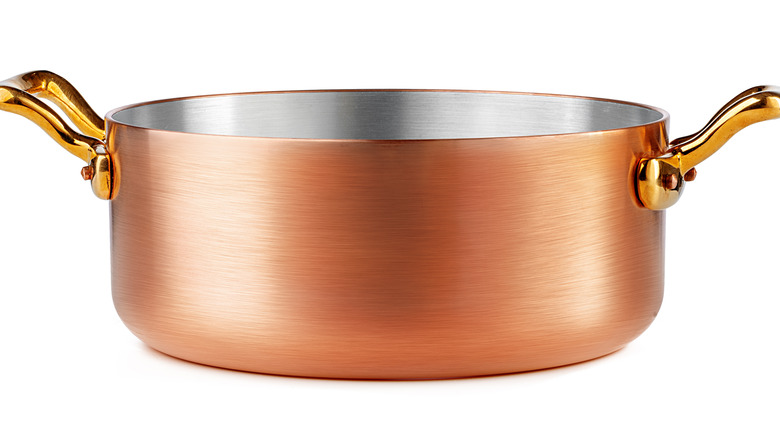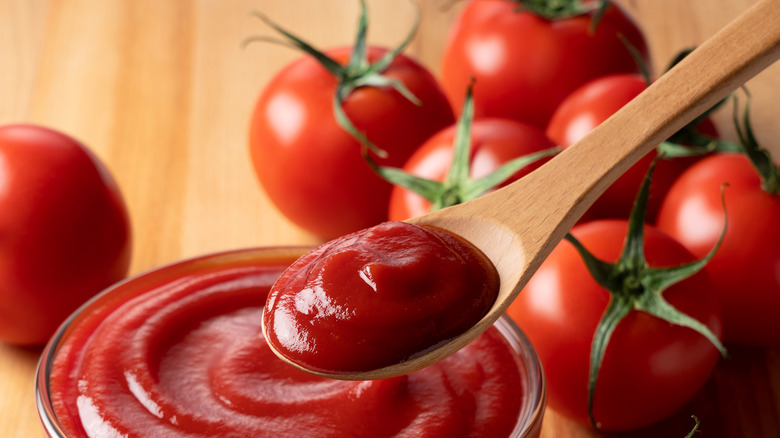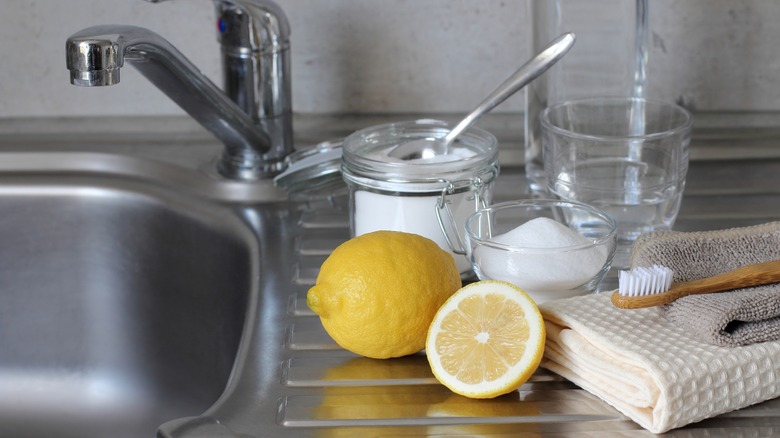The Best Way To Clean Copper Hardware
Chances are, many of your hardware items are either copper, brass, or stainless steel. Designated as Cu in the Periodic Table, copper has been used for more than 10,000 years, per Makin Metal Powder, and it may be the oldest known pure metal. Copper has a distinctive reddish-orange surface, but can rust and tarnish. It is subject to discoloration from various sources; exposure to oxygen, dirt, finger oil, moisture, and grease can transform it to a less desirable green, blue, brown, or black. The greenish Statue of Liberty is a prime example of this color change.
To keep copper pristine, you need to squash those culprits as much as possible, according to The Knowledge Burrow. A regular weekly cleaning routine or a monthly one for copper fixtures is recommended. There are commercial copper-cleaning products that are effective, but expensive, and not environmentally sound. Fortunately, there is also an entire menu of eco-friendly natural cleaners that can restore your copper item to its original appearance and luster. Even better, most of them are readily available, inexpensive household products.
Acid cleans copper
When copper is exposed to acid, a chemical reaction occurs. Copper salts are created, which are soluble and can be rinsed off. A variety of acid-containing products are good copper cleaners. A warning: Acid can strip an applied or lacquered finish from copper, so use it prudently. Home Depot recommends several ways to clean copper using the acid from lemons. Lemons also protect against tarnishing by dissolving the surface of copper oxide.
Try cutting a lemon in half and sprinkling salt on it. Rub the salted cut half on the item and see the results. Mixing lemon juice and salt with non-iodized cornstarch, or adding the juice to baking soda, will form an effective natural cleaning paste. Use a soft sponge or microfiber cloth to apply, then rub, rinse, and dry. A salt/vinegar/flour paste also works well. Everbrite Coatings suggests a concoction of lemon juice and cream of tartar but warns it may scratch copper and is best used only in severe cases.
Tomato paste, ketchup, or spaghetti sauce also clean copper by dissolving copper oxide. None of those will scratch the copper, an added bonus. You can even dip the dirty item into a pan of the stuff. However, some DIYers claim these tomato-based products will impart a salmon tinge on copper's natural appearance. Worcestershire sauce has another use besides a Bloody Mary component — it can clean copper. So can soy sauce. Copper H2O says that rubbing tamarinds a la lemons will also do wonders for surface sheen.
Tips and taboos
An unclean copper item can be placed for several hours in a pot of boiling water, along with a cup of distilled white vinegar and a tablespoon of salt. The Pickled Spruit recommends the following method for cleaning copper handles: Create a cleaning solution of 1 tablespoon of ammonia and a pint of water. Wipe with a soft cloth and buff with a chamois cloth to revive the sheen. The blog also advises spraying a toothbrush with white vinegar and table salt to get into the nooks and crannies. The toothpaste itself can be used for cleaning. A copper object's patina can be protected after cleaning by applying a thin layer of wax or oil. Some contain UV filters, which will slow color and patina deterioration (per Signature Hardware). Good ones to use include carnauba wax, mineral oil, baby or olive oil, and beeswax.
Never put copper in a dishwasher or soak it in water overnight. Don't use bleach to clean it. After cleaning, do not air dry. Water sitting on the object speeds up oxidation and encourages rust and corrosion. Avoid abrasive scrubbers and instead use soft cloths or towels to apply cleaning agents. Epsom salts and bath salts can damage a copper tub, so should also be eschewed. By the way, baking soda and aluminum don't mix — it will damage the surface, as per Oregon Metro.


